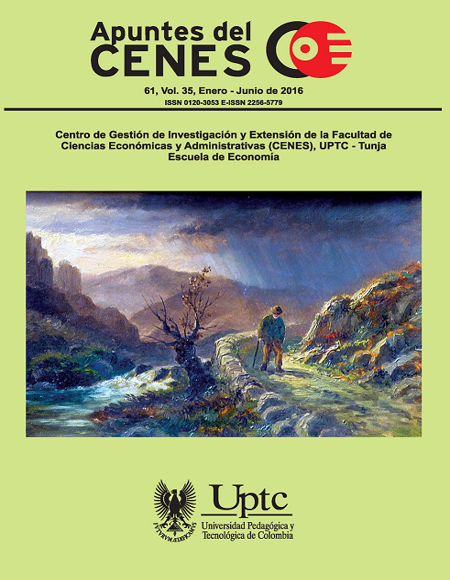Economics and politics of the bolivian model 2006-2014: preliminary assessment

Abstract
Bolivia suffered a profound political and socioeconomic change within
the period 2006– 2014, shifted from a liberal development model to a
mixed economy. The State has a complete control of economic resources
and main incomes of industry. The surplus generated by commodities
contributed to the income distribution policy and also was used for fighting
against poverty by a better education and health. The macroeconomic
model was successful: the Bolivian economy grew at an average rate of
4.6% yearly during the period 2006–2014 and registered a fiscal surplus,
a positive trade balance and an increase in the volume of international reserves.
Now the country has macroeconomic stability and low inflation.
Keywords
economic model, economic growth, government, natural resources, economic policy, macroeconomics, poverty, inflation.
References
- Adelman, I., & Robinson, S. (1989). Income distribution and development. Handbook of development economics, 2, 949-1003. DOI: https://doi.org/10.1016/S1573-4471(89)02006-1
- Aparicio, J. (2007). Bolivia, un futuro incierto. Revista Perspectiva, 12.
- Arévalo, A. (2014). Ecuador: economía y política de las revolución ciudadana, evaluación preliminar. Revista Apuntes del Cenes, 33(58). DOI: https://doi.org/10.19053/22565779.3104
- Banco Central de Bolivia. (2015). Varias estadísticas. Acceso en 2015. Recuperado de:http://www.bcb.gob.bo/?q=estadisticas/sector_externo.
- Baldacci, E., Clements, B., & Gupta, S., (2003). Utilizar la política fiscal para estimular el crecimiento: cuándo se justifica reducir el déficit fiscal en los países de bajo ingreso. Finanzas y desarrollo: publicación trimestral del Fondo Monetario Internacional y del Banco Mundial, 40(4), 28.
- Blanchard, O. (2006). Macroeconomía. (4 ed.). Madrid : Pearson Education.
- Cárdenas, M. (2013). Introducción a la economía colombiana. Bogotá: Alfa y Omega.
- Central Intelligence Agency –CIA- (2014). The world factbook. Estadísticas de AméricaLatina y el Caribe. USA: CIA.
- Cepal. (2013). Datos socioeconómicos de América Latina y el Caribe. Chile: Cepal.
- Cotarrelli, C. & Jaramillo, L. (2012). Walking hand in hand: fiscal policy and growth in advanced economies. Working paper 137. Washington: IMF. DOI: https://doi.org/10.5089/9781475503913.001
- Cuadrado, R. & Mancha, T. (1995). Introducción a la política económica. Madrid: Mc-Graw-Hill.
- Estado plurinacional de Bolivia (2012). Bolivia, características de población y vivienda,Censo Nacional de vivienda, INE, La Paz.
- Estado plurinacional de Bolivia (2012). Ministerio de Economía y Finanzas Públicas, varios números, La Paz.
- Faleiros, V. P. (1980). A política social de estado capitalista. Sao Paulo: Editorial Cortez.
- Fernández, A. & Parejo, J (1995). Introducción a la política económica. Madrid: Mc-Graw-Hill.
- Fisher, S. & Dornbusch, R. (2008). Macroeconomía. México: McGraw-Hill.
- Froyen, R. (1997). Macroeconomía, teorías y políticas. Bogotá: McGraw-Hill.
- García, T. & Turnovsky, S. (2005). Growth and income inequality. A canonic model. Economic Theory, 28(1), 25–45. https://doi.org/10.1007/s00199-005-0616-7 DOI: https://doi.org/10.1007/s00199-005-0616-7
- Galor, O. & Tsiddon, O. (1996). Income distribution and growth: the Kuznets hypothesis revisited. Economica, 63(250), 103-117. https://doi.org/10.2307/2554811 DOI: https://doi.org/10.2307/2554811
- Giddens, A. (1999). La tercera vía: la renovación de la social democracia. Madrid: Taurus.
- Instituto Nacional de Estadısitica (s,f). Información estadística - Pobreza. Recuperado dehttp://www. ine. gov. bo/indice/indice. aspx.
- Johnston, J. & Lefebvre, S. (2014). Bolivia’s economy under Evo in ten graphs. Washington DC, USA: Center for Economic and Policy Research.
- Jones, H. (1998). Introducción a las teorías modernas del crecimiento. Barcelona: Antoni Bosch.
- Keynes, J. (1971). Teoría general de la ocupación, el interés y el dinero. México: Fondode Cultura Económica FCE.
- Federal Research Division. (2006). Country Profile: Bolivia. USA: United States Library of Congress.
- Lucas, R. Jr. (1988). On the mechanics of economic development. Journal of monetary economics. 22(1), 3- 42. https://doi.org/10.1016/0304-3932(88)90168-7 DOI: https://doi.org/10.1016/0304-3932(88)90168-7
- Maddison, A. (1992). The political economy of poverty, equity, and growth, Brazil and Mexico. Washington D.C.: The World Bank.
- Mankiw, G (2003). Macroeconomics. New York: Worth Publishers.
- Ortiz, I. (2007). La política social, estratégicas de desarrollo. Nueva York: ONU.
- Quarterly, A. (2014). The Social Inclusion Index 2014. Americas Quarterly.
- Sachs, J. (2006). El fin de la pobreza, cómo conseguirlo en nuestro tiempo. Bogotá: Debate.
- Santos, J.M. & Blair, T. (1999). La tercera vía: una alternativa para Colombia. Bogotá:Aguilar.
- Solow, R. M. (1956). A contribution to the theory of economic growth. The quarterly journal of economics, 70(1), 65-94. DOI: https://doi.org/10.2307/1884513
- Steffan, D. (S.F.). El socialismo del siglo XXI. Segunda edición, México. D.F.
- Steffanoni, P. & Do Alto, H. (2007). La revolución de Evo Morales: de la coca al palacio.Buenos Aires: Editorial Capital Intelectual.
- Steffanoni, P. & Do Alto, H. (2007). El nacionalismo indígena al poder, publicación.Buenos Aires: Osal Observatorio Social de América Latina, Clacso.
- Taylor, J. & Weerapana, A. (2010). Principles of Economics, South–Western. New Jersey,USA: Cengage Learning.
- Ways, T. (2014). El Bolivarianismo. Recuperado de Elheraldo.com
- Zamora, A. (2014). BBC mundo: Bolivia, el secreto del éxito. Londres: De Morales.